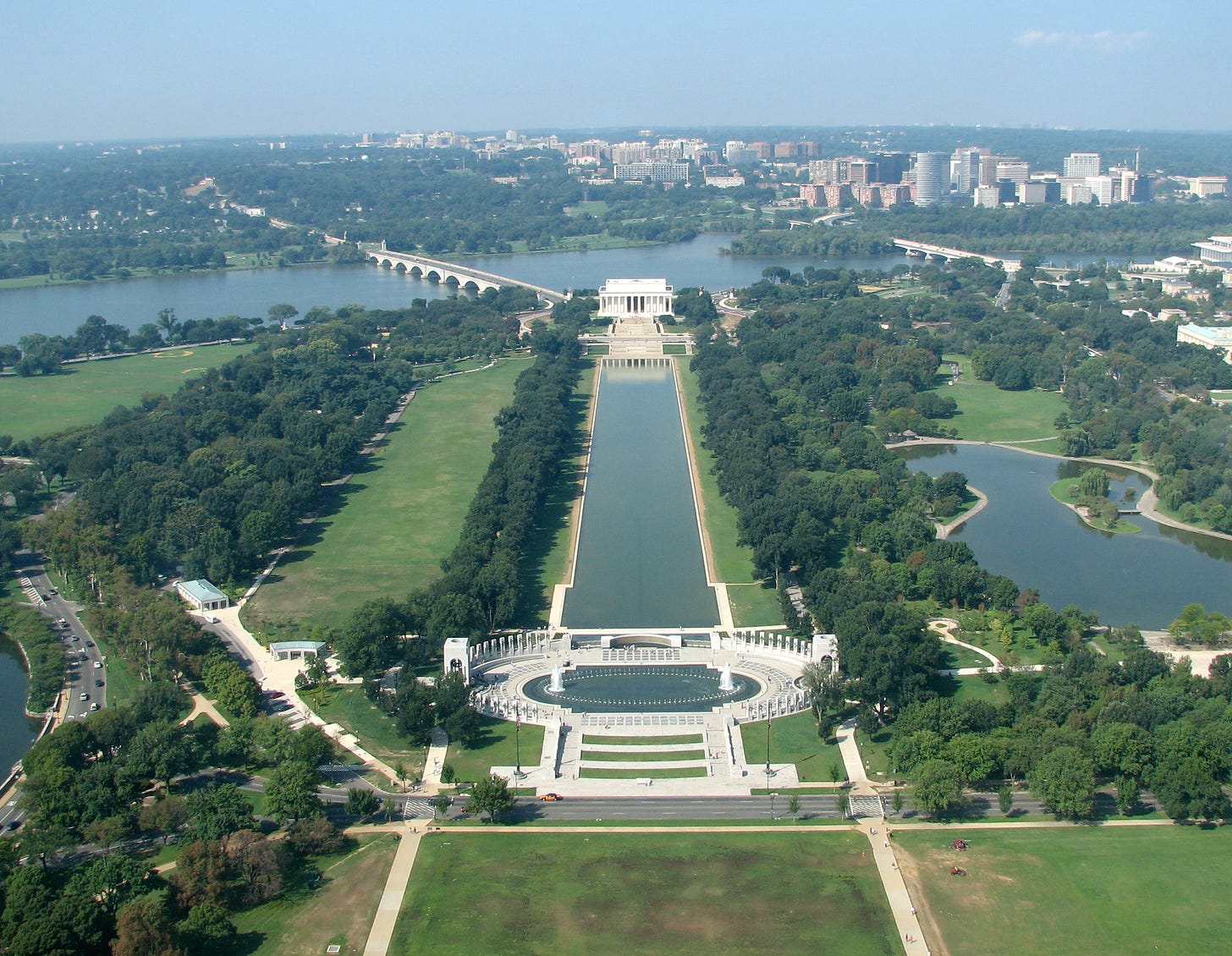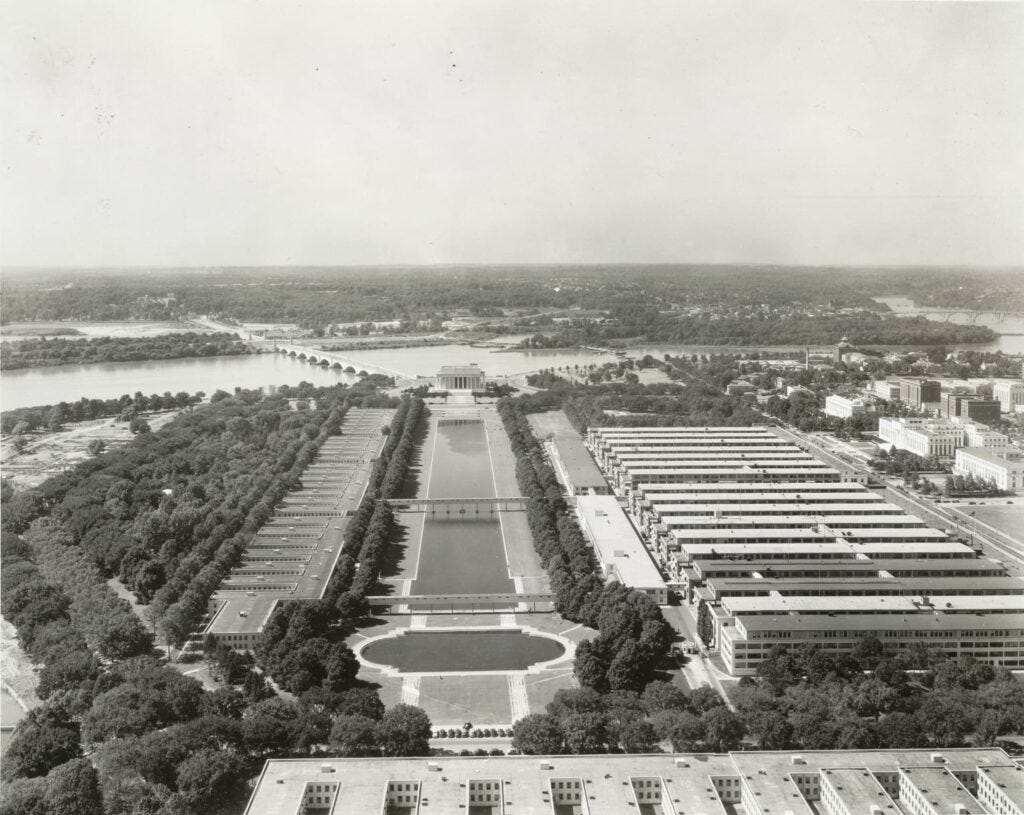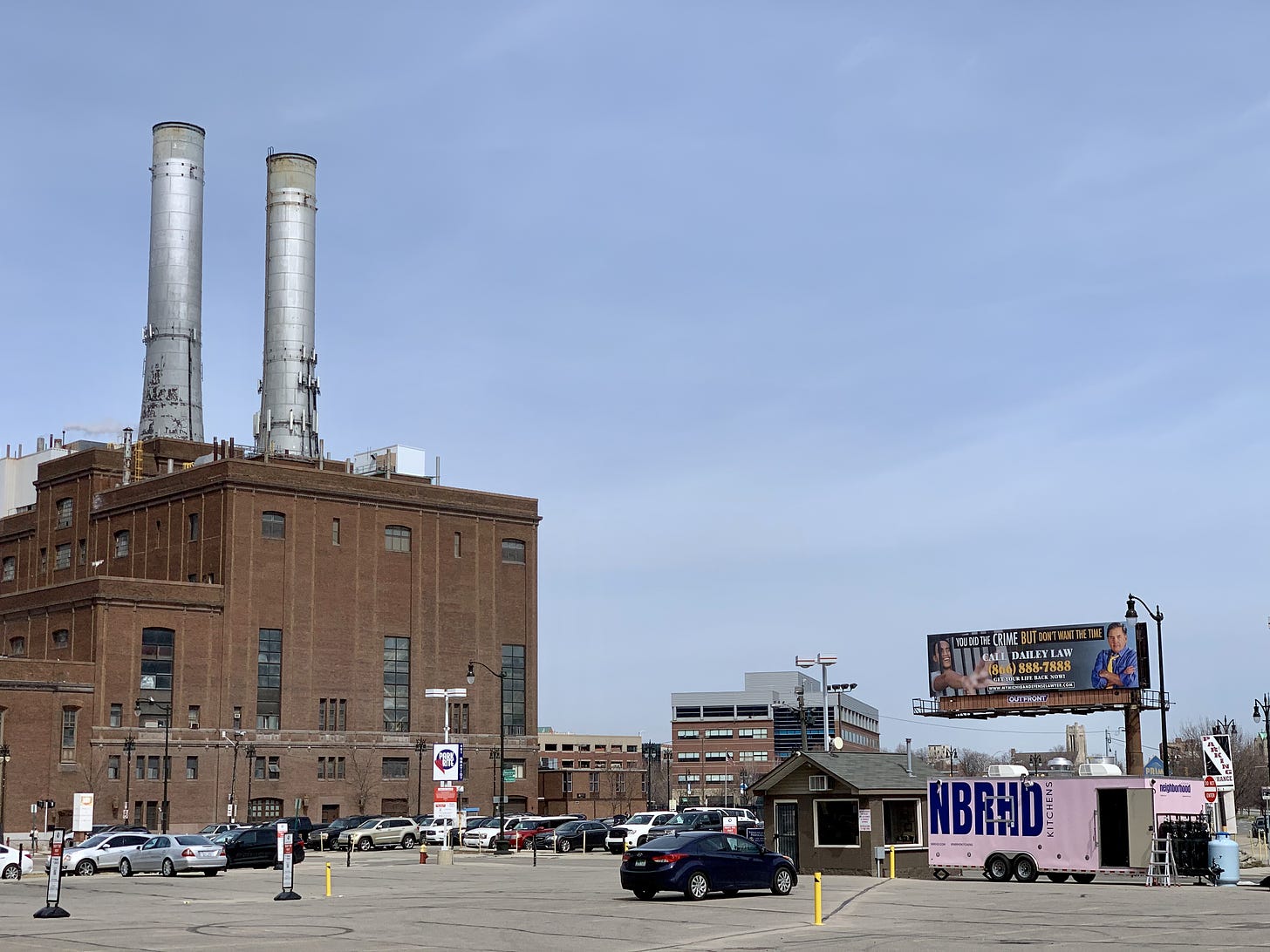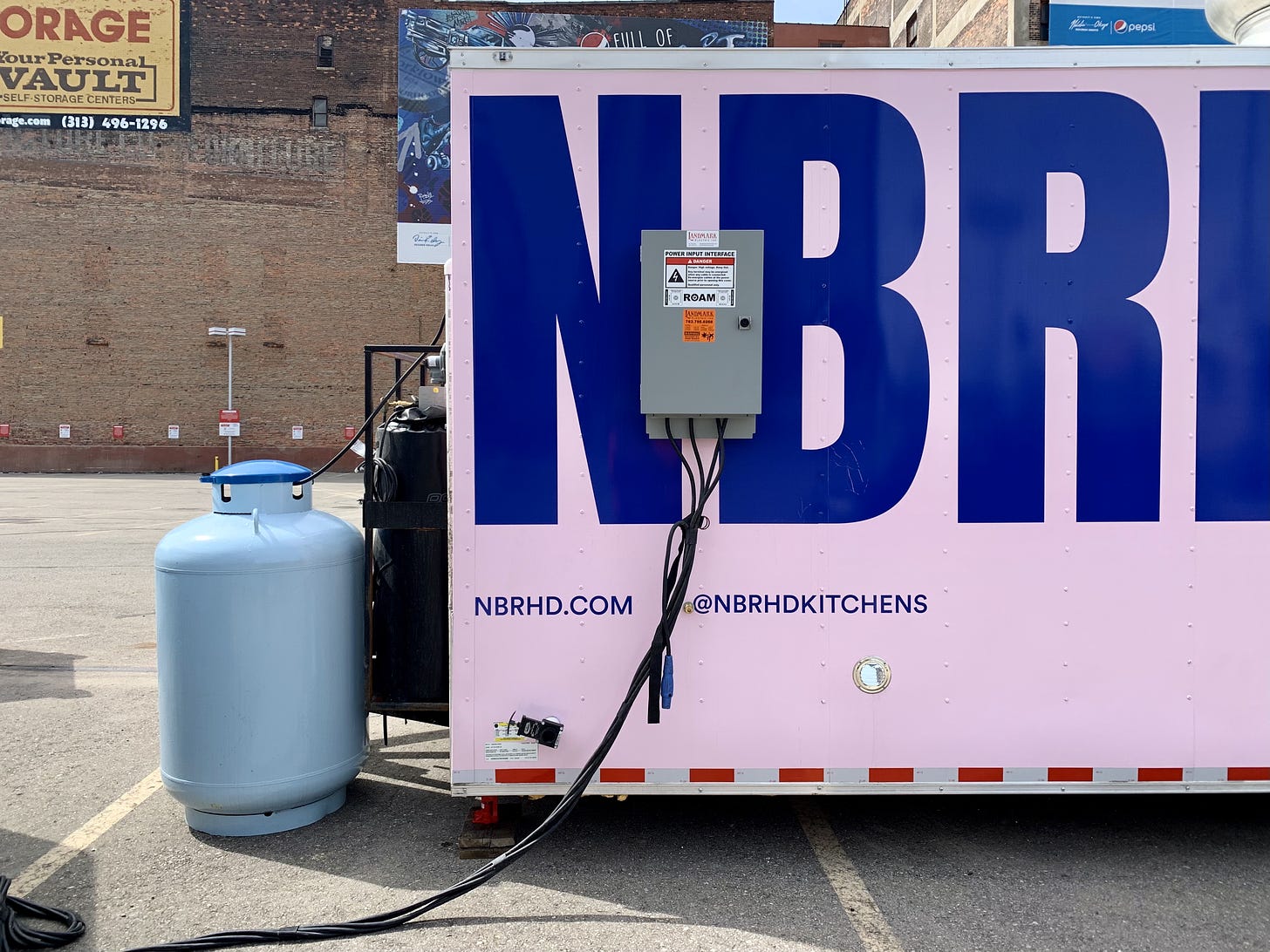Urban Technology at University of Michigan week -13
How shall we fill up the empty spaces of the city?
Take a walk through downtown Detroit this week and you’ll spot a pink trailer labeled “NBRHD.” Ghost kitchens have arrived in Michigan. The concept is that restaurants don’t need a seating area to satisfy your need for food. Instead, ghost kitchens shift the cooking to some cheap, anonymous space and then shuttle the cooked meal to the customer via delivery. Usually, insofar as we can use the word “usually” in reference to a concept that is just a few years old, ghost kitchen space is reclaimed from empty floors of an office building, blank facades of a strip mall, or by repurposing space down some alley that customers would never visit even if the muffins were fantastic. Here in Detroit, however, the ghost kitchen has landed in the middle of a parking lot prominently located on Gratiot, a major street. (If you read that and thought, why is there a surface parking lot anywhere in downtown Detroit, I applaud you.)
NBRHD gives us a chance to think about the way the physical spaces of cities bend and flex to accommodate (or thwart) cultural change. Downtown parking lots are a pretty bad use of space as a location to let your expensive, metal, non-public transit bake in the sun, but they can be expedient places to experiment with new ways of facilitating urban life. Let’s stretch our brains and get optimistic about empty lots. To start, we have to jump from Detroit to DC.
Hello! I’m Bryan Boyer, Director of the Urban Technology degree at University of Michigan that will welcome its first students soon. If you’re new here, try this 90 second video introduction. While we launch the program, we’re using this venue to explore themes and ideas related to our studies. Thanks for reading. Have questions about any of this? Hit reply and let us know.
🔮 Even the Unknowns Unknowns Live Somewhere
Take a look at these two pictures of the National Mall in Washington, DC, some sixty years apart. First a recent view and then roughly the same perspective atop the Washington Monument, seen during the World War II era.


Where the photo above shows the Constitution Gardens, Vietnam Memorial and other ceremonial areas as spacious open areas, the photo below depicts millions of square feet of office space. This occupation of the mall with government buildings started during World War I and continued until the 1970s when they were finally demolished. The Mall has also been temporary home to gardens, slums, rallying grounds, rail yards, canals, and marches, and was recently the staging grounds for an attack on the US Capitol. For better or for worse, the Mall is America’s expansion slot.
It’s the space at the center of the nation’s government where the unexpected can be accommodated, whether that’s for a moment of collective expression, reflection, or the work of maintaining a war bureaucracy. If the US government were a Nintendo, the National Mall would be where we plug in the new game cartridges.
The video game analogy sounds a little odd, but it foregrounds the flexibility of empty land. The National Mall is where the “temporary” war buildings were constructed because it was empty but for plantings. Expanding there was the path of least resistance. When the wars passed, the buildings were removed (eventually). As I’ve written about previously in the journal CLOG, I’m optimistic about empty spaces because a certain degree of emptiness is required to have the room to react to unknown unknowns. Cities that can predict everything do not need empty spaces—but no such cities exist. Not even in a Calvino book!
DC and the National Mall are an exceptional case but many cities have a version of this promising emptiness today in the form of parking lots, and that brings us back to NBRHD. Behold:
While I wish this ground was filled with housing, downtown Detroit’s surface parking lots provide room for experimentation such as the arrival of this ghost kitchen pod. Here an anonymous trailer is parked next to what appears to be a generator, propane tanks, and a grease bin. As a citizen of the city it’s not the nicest thing to have to look at while passing by, but probably not any worse than staring at parked cars. It’s smart of a company like Reef Technology to find new uses for parking lots. Actually, in the case of this particular lot, they’re formalizing a cultural rhythm that occurs in this very same parking lot. During football season, this pink trailer is located where Detroit Lions tailgaters would usually be praying for a win. (If you want to talk about optimism, look no further than diehard Lions fans.)
So yes, a ghost kitchen that introduces some new food options is better than an underutilized surface parking lot, but it’s still not what the real estate folks would call the highest and best use. To tie this back to the Urbanist vs. Technologist table from last week, privately owned parking lots are not precisely a commons, but finding new use for a blank space in the city is a classic example of unexpectedly exploiting for private gain something that is otherwise agreed to be utilized within certain limits of decorum (parking lots are for cars, not restaurants). The upsides (cheap kitchen and central location) are private, but the downsides (a hodgepodge of trash and energy infrastructure cluttering up the public realm around the NBRHD pod) are all public.
Still, empty lots are interesting because they allow for cheap experimentation of use, which can be valuable in moments of cultural transition. And, of course, room to change plans and experiment is hard to come by in cities that are already full of buildings occupied by tenants paying hefty rents. To put that in different terms, when it comes to urban land use, Detroit’s parking lots mean it has less path dependency than coastal center like San Francisco or NYC. That’s a good thing. A decade ago the rise of food trucks created a similar wave of recalibration between the space inside buildings (e.g. traditional restaurants) and the public realm of parking spaces, curbs, and surface lots. Ghost kitchens present an even more flexible, yet even less social version of urban food production compared to food trucks! It’s tough to make sense of whether this is, on balance, a good idea which is again one of the reasons why we’re excited to be launching this program. Smarter, younger minds will find new ways to capture the positive flexibility of NBRHD without capitulating to the downsides.
What else can happen in the promising emptiness of a parking lot? A more civic minded approach would be to imagine this space utilized for whatever the city needs right now. Today that would likely be COVID response. At another time it might be non-emergency medical facilities, overflow space for the nearby federal and county courts, a job training center, electric vehicle charging infrastructure, recycling sortation center, skate parks, or bicycle parking and upkeep. It’s a bit more out there, but I would love to see the City of Detroit use more of the vacant lots downtown as a nursery for trees and plants intended to repopulate our parks and public spaces, and reducing urban heat island while we’re at it. Multiple blocks of land slated for a mixed use project called the Monroe Blocks are sitting fallow in the center of downtown—until that turns into a construction site, what productive use could be made of that emptiness?
Links
🔺 How much more tolerance would we have for ghost kitchens blankly filling up urban fabric if they looked better by, say, being inexplicably triangular? Quite a bit more.
💼 Wework will go public using a SPAC (that’s wall Street for '“shortcut”) and their investment deck is pretty fascinating. Among the more salient nuggets is that they are targeting 65% of memberships to be from enterprises (big companies) rather than entrepreneurs. The rise of Wework was about enabling individual, small teams, and startups but the long term stability is in being a high-touch landlord for the Microsofts and Deloittes of the world. NBRHD is an initiative of Reef Technologies, which itself was was backed by the same investment fund, Softbank, that gave Wework its war chest. If NBRHD follows a similar path, their story is almost certainly to be less about serving as a platform for local chefs (current angle) and more likely a new form of elasticity for national chains like Red Lobster and Wendys. Will be watching though. Surprise us, Reef!
🚢 Canals are another thing that represents a productive form of emptiness, but not this week. The Ever Given is clogging up global logistics after becoming stuck in the Suez Canal and it’s already a meme machine.
📦 Who are we kidding, all empty and spaces in cities moving forward are likely to be filled with logistics of one kind or another. Parked cars will be replaced by parked packages. A recent report from the European Commission on urban logistics cites four areas of future focus and three of them are about shuffling boxes.
☎️ A space we enjoy as often empty now, but was not so in the past: airspace. These photos of telephone lines from the 19th century are wild. Soon they may be filled again, but this time with drones rather than wired. h/t Kanyi Maqubela
This week: admissions letters loaded into the machine (spreadsheet) and preparing to shoot out to students in the coming days. No turning back now! Had an Important Group Call, a discussion on hiring for our project manager position, and a great catch up with Josh. Trey’s editing work on an interview series has produced a flurry of notes back and forth. He’s on fire! 🏃♂️





“ but finding new use for a blank space in the city is a classic example of unexpectedly exploiting for private gain something that is otherwise agreed to be utilized within certain limits of decorum (parking lots are for cars, not restaurants”
Have you looked at Portland’s experience with lining parking lots with food trucks? - and then coming up with a new zoning designation for “food pods”